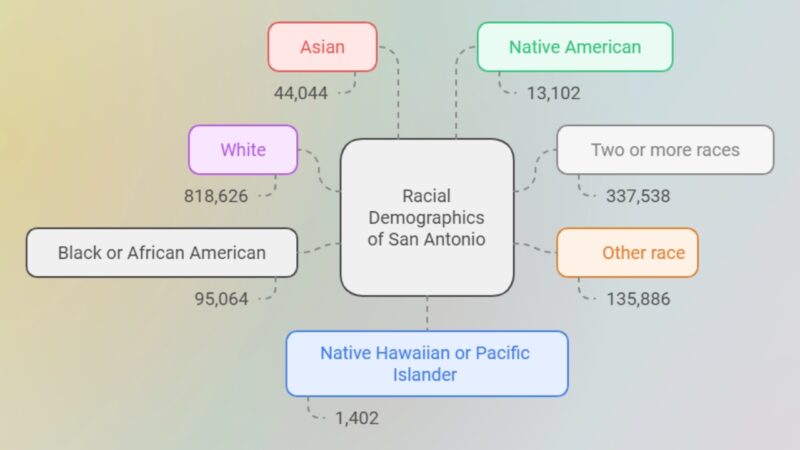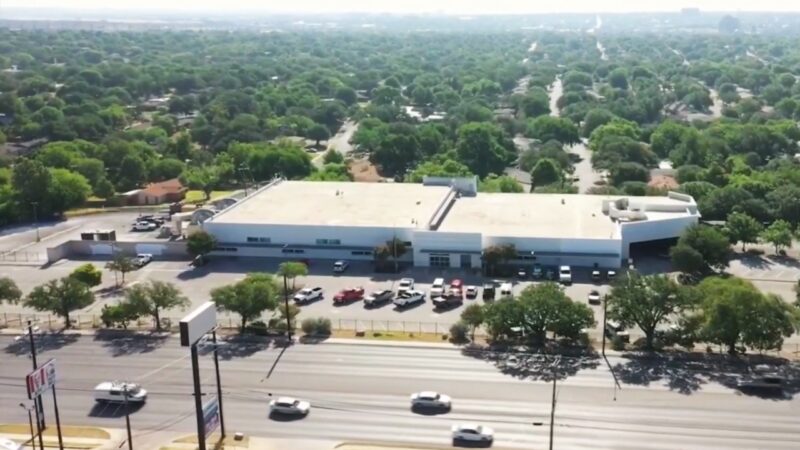Recent data highlights that the city’s population has surged to 1,513,974 in 2025, indicating an annual growth rate of 1.25%.
This burgeoning population reflects a 5.19% increase since the last census, marking San Antonio not just as a city of growth but as a tapestry of diverse hopes and dreams.
Migration has been a crucial factor driving San Antonio’s continuous growth, reshaping its demographic and economic landscapes.
The city attracted nearly 22,000 new residents between mid-2022 to mid-2023, positioning it as the seventh most populous city in the United States. This consistent influx has allowed San Antonio to maintain its reputation for affordable living while offering a high quality of life.
Demographic Overview of San Antonio

In 2025, San Antonio’s population is estimated to reach 1,513,974, according to World Population Review. This marks an increase from previous years with growth attributed to various factors, including economic opportunities and quality of life.
The higher population figures align with the city’s strategic plans to accommodate growth through infrastructure development, housing, and community services.
Simultaneously, the San Antonio metro area is projected to have a population of 2,491,000, signifying its importance as a key urban center in Texas
Racial Demographics of San Antonio

- White Population: The largest racial group in San Antonio is White, comprising about 56.63% of the population as per Neilsberg.
- Diversity of Two or More Races: A significant portion of the population identifies with two or more races, making up 23.35%, reflecting the city’s increasingly multicultural character.
- Other Race: At 9.4%, a considerable segment of the population is classified under “Other race,” which may include various ethnicities not captured by the primary categories.
- Black or African American: 6.58% of San Antonio’s population is Black or African American, contributing to the city’s rich cultural diversity.
- Asian Population: Although smaller, the Asian community makes up 3.05% of the total population, representing another layer of diversity.
- Native American and Native Hawaiian/Pacific Islander: These groups represent smaller segments of the population, with Native Americans at 0.91% and Native Hawaiians or Pacific Islanders at 0.1%.
Migration Dynamics
San Antonio’s affordable housing and robust job market, particularly in sectors like healthcare, finance, and technology, have attracted residents from across Texas and neighboring states. In 2022, over 10,000 building permits were issued for new residential units, highlighting the city’s rapid housing development to accommodate the influx of new residents. This trend has been bolstered by migration from cities like Austin, where housing costs are significantly higher according to Newmark.
San Antonio Report notes that in between 2010 and 2019, the San Antonio-New Braunfels metropolitan area saw a net migration of 259,857 people. During this period, developers constructed 55,100 new apartment units, primarily within San Antonio’s city limits, to meet the growing demand.
The median home price in San Antonio has indeed increased by about 30% over the past five years. As of January 2023, the median home price was reported to be $299,000, a 3% increase compared to the previous year.
This follows consistent growth in housing prices across the city, although it remains more affordable compared to other major Texas cities like Austin, where the median price was $500,000 as per Realtor.
International Migration and Contributions

International migration has also played a critical role in shaping San Antonio’s population and economy. The city has become a major transit point for migrants traveling through Texas.
Since early 2021, over 600,000 international migrants have passed through the city, and in 2022 alone, U.S. Customs and Border Protection detained more than 2.3 million migrants along the southern border, with many passing through San Antonio.
The city continues to operate the Migrant Resource Center, which provides temporary shelter, food, and services to migrants before they move on to other destinations.
In terms of economic impact, over 30% of San Antonio’s business owners are immigrants, reflecting their significant contribution to the city’s local economy. Immigrants also play a vital role in the workforce, further reinforcing San Antonio’s economic resilience.
Demographic and Economic Impact
The continued growth of both domestic and international migration has enriched San Antonio’s cultural landscape, with around 41% of residents speaking a language other than English at home, predominantly Spanish. This diversity has fostered a vibrant community that celebrates a blend of traditions and cultures.
Federal Reserve Bank of Dallas notes that San Antonio’s GDP reached approximately $163 billion in 2022, reflecting an impressive 11.2% increase from the previous year. This growth is largely driven by an influx of both domestic and international migration, which has bolstered the city’s workforce and contributed to demand in key sectors such as healthcare, finance, and technology.
As new residents move to San Antonio, there is increased demand for housing, services, and infrastructure, which in turn supports local businesses and fuels economic expansion
Economic Factors
Employment Opportunities
San Antonio offers a variety of job opportunities, particularly in key sectors like healthcare, military, tourism, and technology. Here are the approximate numbers of jobs available in these sectors:

- The healthcare sector is a significant employer, with over 220,000 jobs, mainly due to major institutions such as the South Texas Medical Center.
- The military employs around 80,000 people in and around the city, due to the presence of major bases like Joint Base San Antonio.
- The tourism industry, driven by attractions such as the Alamo and River Walk, supports over 150,000 jobs.
- The technology sector, while smaller, is growing rapidly as the city promotes itself as a new tech hub.
Housing Market Conditions
The housing market has historically been one of San Antonio’s strongest appeals. Below are figures related to the housing market, showing the increase in prices and availability of affordable housing:
Year
Median Home Price
Increase Over 5 Years
Affordability Compared to Other TX Cities
2018
$230,000
+30%
More affordable than Austin and Dallas
2023
$299,000
+30%
Median price in Austin is $500,000
- The median home price increased by approximately 30% over the past five years, from $230,000 in 2018 to $299,000 in early 2023 as per 210 Realty Group.
- Despite rising prices, San Antonio remains significantly more affordable than Austin, where the median price is around $500,000.
- The housing market in Dallas has also experienced notable growth, with prices rising steadily but still remaining below those in Austin.
Cost of Living and Quality of Life
San Antonio’s cost of living is relatively low compared to other major cities in Texas, making it attractive for migrants. Here are some comparative figures:
Cost Factor
San Antonio
Austin
Dallas
Median Home Price (2023)
$299,000
$500,000
$338,500
Average Rent (2023)
$1,040/month
$1,600/month
$1,463/month
Cost of Living Index
89.3
119.3
101.6
- The average rent in San Antonio remains below the national average at around $1,040 per month
- The cost of living index in San Antonio is 89.3, compared to 119.3 in Austin, reflecting its relative affordability
These statistics showcase how employment, housing affordability, and a low cost of living drive migration to San Antonio, despite the challenges posed by rising housing costs and economic inequality in certain communities.
Social Impact of Migration
San Antonio is home to a richly diverse population, with Hispanic residents making up around 64% of the total, followed by White, African American, and Asian communities. This diverse demographic enhances the city’s cultural landscape through various festivals, foods, and traditions, contributing to a vibrant multicultural environment.
The city has long been a hub for migrants, especially from Latin America, and has built infrastructure, like the Migrant Resource Center, to assist and integrate new arrivals.
The Migrant Resource Center, established in collaboration with Catholic Charities, plays a vital role in connecting migrants with essential services, including housing, transportation, and legal assistance.
Impact on Education and Healthcare Services
A San Antonio hospital that’s continuing to expand to keep pace with rising demand for care in one of the city’s high-growth areas is under new executive leadership. https://t.co/LifBVEJMfg
— San Antonio Business Journal (@SABizJournal) April 16, 2024
The influx of migrants has put a strain on public services such as education and healthcare. Local schools have adapted by hiring more bilingual teachers and implementing culturally inclusive curricula to support the diverse student body.
Texas Public Radio, notes that healthcare systems are facing increased demand, particularly in lower-income and immigrant-heavy areas where disparities in access and health outcomes persist. These issues are compounded by the need for culturally sensitive care and services delivered by multilingual healthcare providers.
Community Infrastructure and Services
The rapid population growth driven by migration is reshaping San Antonio’s infrastructure. The city has seen a rise in housing demand, prompting increased investment in affordable housing and transportation improvements.
Daily San Antonio News notes that efforts are being made to expand bus routes and ensure equitable access to services across all neighborhoods, particularly for migrant populations. The development of community services, supported by government and non-profit collaboration, is essential for ensuring a cohesive and functional urban environment.
Government Policy and Immigration Law

The local government in San Antonio plays a pivotal role in addressing immigration through targeted initiatives. The city maintains a Migrant Resource Center, essential for managing the influx of migrants. Despite a decrease in usage, it remains operational, supported by budget allocations ensuring assistance through various stages of the migrant journey.
Additionally, San Antonio ranks highly in immigrant integration efforts, emphasizing support for new arrivals in housing, employment, and community engagement. This focus on integration has cemented the city’s reputation for accommodating and supporting a diverse population.
State Legislation and Impact
Texas has transported over 100,000 migrants to sanctuary cities to relieve overwhelmed border towns.
Until Biden reverses course on his open border policies, Texas will continue transporting migrants to these cities.
We will not back down on our efforts to secure the border.
— Greg Abbott (@GregAbbott_TX) January 9, 2024
Texas state legislation significantly influences San Antonio’s immigration landscape. State laws regarding sanctuary cities and law enforcement cooperation with federal immigration authorities impact how San Antonio agencies handle migrant interactions.
While not a sanctuary city, San Antonio fosters a cooperative relationship with local law enforcement to ensure public safety without alienating migrant communities. This approach balances compliance with state laws and the city’s commitment to human rights. Such legislation shapes the broader context in which local initiatives operate, affecting resources and strategies available to support the migrant population.
Legal professionals also play an essential role in supporting migrant integration across San Antonio. The Echavarria Law Firm provides vital immigration legal services that help families secure lawful status, navigate complex paperwork, and access community resources. The firm’s commitment to advocacy contributes to the city’s broader efforts to maintain fairness, safety, and inclusion for newcomers seeking a stable future in San Antonio.
Federal Immigration Reform and San Antonio
Federal immigration policies also have considerable implications for San Antonio. Changes in federal laws, such as the discussion around Title 42, illustrate potential shifts in how migrants are processed and supported.
Although local leaders, like the mayor, assert minimal impact from such federal changes on immediate operations, any reform can lead to adjustments in city resources and strategies for migrant assistance. San Antonio must navigate evolving federal landscapes, aligning local policy to ensure continued support and integration for those arriving at the city’s doorstep.
Conclusion

San Antonio has experienced significant population growth due to various factors, primarily driven by migration. The city’s affordability and economic opportunities continue to attract a diverse population.
Migration has notably impacted San Antonio’s demographics. Recent data shows the city’s population increased by nearly 22,000 residents from July 2022 to July 2023, bringing it to approximately 1,495,295 inhabitants.
One important aspect of this growth is the contribution of immigrants. In 2017, immigrants constituted 30.3% of business owners, highlighting their vital role in the local economy.
The city’s focus on becoming more welcoming to immigrants is evident. Efforts have positioned San Antonio as a leader in immigrant integration, ranked first in Texas. The City of San Antonio provides insights into these integration efforts.
San Antonio remains an attractive destination for new residents. By leveraging data and fostering an inviting environment, the city seeks to accommodate its growing population effectively, ensuring continued prosperity and diversity.
Related Posts:
- San Francisco’s Population Loss Among Biggest in the US
- Statistics on Statin Use in The US - The Impact of…
- Alcohol and Its Deadly Impact - U.S. Stats on…
- New York State Population - 2025 Growth, Decline,…
- US Prepares for Climate Migration with "Receiving…
- How Does Population Parameter Differ from Sample Statistic?








